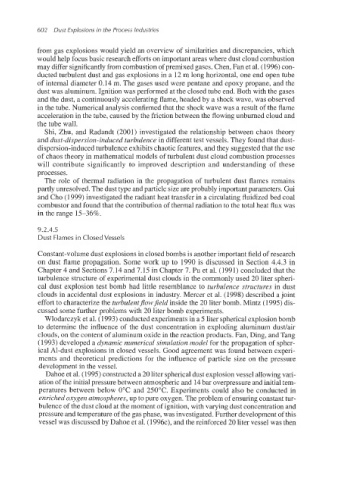Page 635 - Dust Explosions in the Process Industries
P. 635
602 Dust Explosions in the Process Industries
from gas explosions would yield an overview of similarities and discrepancies, which
would help focus basic research efforts on important areas where dust cloud combustion
may differ significantlyfrom combustion of premixed gases. Chen, Fan et al. (1996) con-
ducted turbulent dust and gas explosions in a 12 m long horizontal, one end open tube
of internal diameter 0.14 m. The gases used were pentane and epoxy propane, and the
dust was aluminum. Ignition was performed at the closed tube end. Both with the gases
and the dust, a continuously accelerating flame, headed by a shock wave, was observed
in the tube. Numerical analysis confirmed that the shock wave was a result of the flame
acceleration in the tube, caused by the friction between the flowing unburned cloud and
the tube wall.
Shi, Zhu, and Radandt (2001) investigated the relationship between chaos theory
and dust-dispersion-induced turbulence in different test vessels. They found that dust-
dispersion-inducedturbulence exhibits chaotic features, and they suggested that the use
of chaos theory in mathematical models of turbulent dust cloud combustion processes
will contribute significantly to improved description and understanding of these
processes.
The role of thermal radiation in the propagation of turbulent dust flames remains
partly unresolved. The dust type and particle size are probably important parameters. Gui
and Cho (1999) investigated the radiant heat transfer in a circulating fluidized bed coal
combustor and found that the contribution of thermal radiation to the total heat flux was
in the range 1536%.
9.2.4.5
Dust Flames in Closed Vessels
Constant-volumedust explosionsin closed bombs is another important field of research
on dust flame propagation. Some work up to 1990 is discussed in Section 4.4.3 in
Chapter 4 and Sections 7.14 and 7.15 in Chapter 7. Pu et al. (1991) concluded that the
turbulence structure of experimental dust clouds in the commonly used 20 liter spheri-
cal dust explosion test bomb had little resemblance to turbulence structures in dust
clouds in accidental dust explosions in industry. Mercer et al. (1998) described a joint
effort to characterize the turbuZent$ow$eld inside the 20 liter bomb. Mintz (1995) dis-
cussed some further problems with 20 liter bomb experiments.
Wlodarczyk et al. (1993) conductedexperimentsin a 5 liter sphericalexplosionbomb
to determine the influence of the dust concentration in exploding aluminum dudair
clouds, on the content of aluminum oxide in the reaction products. Fan, Ding, and Tang
(1993) developed a dynamic numerical simulation model for the propagation of spher-
ical Al-dust explosions in closed vessels. Good agreement was found between experi-
ments and theoretical predictions for the influence of particle size on the pressure
development in the vessel.
Dahoe et al. (1995)constructed a 20 liter spherical dust explosion vessel allowing vari-
ation of the initialpressurebetween atmospheric and 14bar overpressureand initial tem-
peratures between below 0°C and 250°C. Experiments could also be conducted in
enriched oxygen atmospheres, up to pure oxygen. The problem of ensuring constanttur-
bulence of the dust cloud at the moment of ignition, with varying dust concentrationand
pressure and temperatureof the gas phase, was investigated.Further development of this
vessel was discussed by Dahoe et al. (1996c), and the reinforced 20 liter vessel was then

